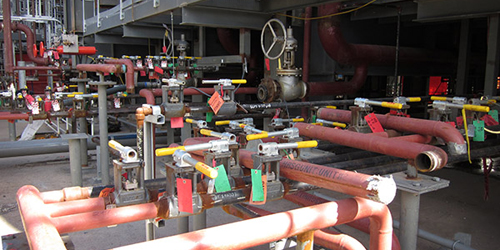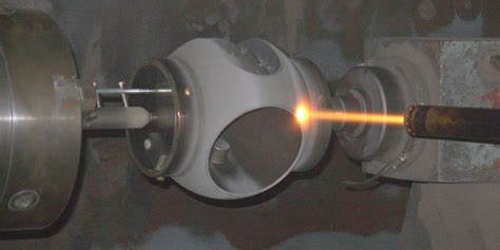Valve industry has specific terms, different parts have their own terminology. For example, solenoid valve also called electromagnetic valve, the motorized valve also named electric actuator valve, pneumatic actuator valve also named air actuator valve. Below we will introduce the terminology from the basic professional knowledge of the valve and the valve structure.
BASIC TERMINOLOGY FOR VALVES
1. Strength Properties
Valve strength performance refers to the ability of the valve to withstand medium pressure. Valves are mechanical products that can withstand internal pressure and must therefore have sufficient strength and stiffness to ensure long-term use without rupture or deformation.
2. Sealing Performance
The sealing performance of valve refers to the ability to prevent the leakage of media at the sealing part of valve, which is the most important technical performance index of valve.
There are three sealing parts of the Valve: The opening and closing piece and the valve seat between the two sealing surface of the contact; packing and stem and packing letter with the place; Valve Body and Bonnet Joint. One of the previous leak is called the internal leak, which is often referred to as the slack, it will affect the ability of the valve to cut off the media. For shutoff valves, internal leakage is not allowed. The last two leakage is called leakage, that is, media leakage from the valve to the valve outside. Leakage will cause material loss, pollution of the environment, serious will also cause accidents.
For flammable explosive, toxic or radioactive media, leakage is not allowed, so the valve must have reliable sealing performance.
3. Flowing Media
Media Flow through the valve will produce pressure loss (both the pressure difference before and after the valve) , that is, the valve has a certain resistance to the flow of media, media to overcome the resistance of the valve to consume a certain amount of energy. In order to save energy, it is necessary to reduce the resistance of the valve to the flow medium when designing and manufacturing the valve.
4. Opening And Closing Force And Opening And Closing Moment
Opening and closing force and opening and closing moment are the force or moment that must be exerted to open or close the valve. When the valve is closed, a certain sealing specific pressure needs to be formed between the opening and closing parts and the two sealing surfaces of the engine seat At the same time, to overcome the friction between the valve stem and packing, between the valve stem and nut threads, the valve stem end support and other friction parts, so it is necessary to impose a certain closing force and closing Torque, the valve in the open and close process, the required opening and closing force and opening and closing torque are variable, the maximum of which is at the final instant of closing or at the initial instant of opening. Valves should be designed and manufactured to reduce their closing force and closing torque.
5. Opening And Closing Speed
The opening and closing speed is expressed by the time it takes the valve to complete an opening or closing action. Generally, there is no strict requirement for the opening and closing speed of valves, but some operating conditions have special requirements for the opening and closing speed. For example, some require quick opening or closing to prevent accidents, and some require slow closing to prevent water hammer, etc. This should be considered when selecting the valve type.
For example: require multiple switch, and require switching speed is extremely fast, but short running time we will recommend solenoid valve. Electric Valves are recommended if they require a long running time but do not require a high switching speed.
6. Motion Sensitivity And Reliability
This refers to the valve for the medium parameter changes, make the corresponding response sensitivity. The function sensitivity and reliability of throttle valve, pressure reducing valve, regulating valve, safety valve and steam trap are very important technical performance indexes.
7. Life Expectancy
It indicates the durability of the Valve, the valve is an important performance indicators, and has great economic significance. Usually to ensure the sealing requirements of the number of times to express, can also be used to express time. Our pneumatic valves are well received with a life of one million cycles.
8. Types
Classification of valves by purpose or main structural characteristics
9. Model
According to type, transmission mode, connection form, structural characteristics, seat sealing surface material and nominal pressure on the number of valves.
10. Connection Size
Dimensions of valve and pipe connections
11. Main Dimensions
Valve opening and closing height, handwheel diameter and connection dimensions, etc. .
12. Connection Type
Various methods (Such as flanged connection, threaded connection, welded connection, etc.) used to connect valves to piping or machinery.
15.Seal Test Pressure
The specified pressure at which the valve is subjected to a sealing test.

16. Use Media
Suitable medium for valve. Generally by the material as well as the sealed material decision.
17. Temperature Appropriate
The temperature range of the medium suitable for the valve.
18. Sealing Face
The opening and closing parts are closely fitted with the valve seat (body) , and the two contact surfaces play a sealing role.
19. Open And Close Disc
A general term for a component used to cut or regulate the flow of a medium, such as a gate in a gate valve, a disc in a throttle valve, etc. .
20. Packing
Fill in stuffing box to prevent leakage of media from stem.
21. Packing Seat
A part that supports the packing and maintains the packing seal.
22. Packing Gland
A part that compresses the packing to achieve a seal.
23. Bracket Yoke
Part of a valve cover or body that supports the stem nut and transmission mechanism.
24. Dimension Of Connecting Channel
Constructional dimensions of the assembly joint of the headstock and valve stem.
25. Flow Area
The minimum cross-sectional area (but not the “curtain” area) between the inlet end of the valve and the seating surface of the seat to calculate the theoretical displacement without any resistance effect.
26. Flow Diameter
The diameter corresponding to the runner area.
27. Flow Characteristics
Under the condition of steady flow, when the inlet pressure and other parameters are invariable, the function relationship between the outlet pressure and the flow rate of the pressure reducing valve is obtained.
28. Flow Characteristics Bias
When the inlet pressure and other parameters are invariable, the change value of the outlet pressure caused by the change of the flow rate of the pressure reducing valve under the condition of steady flow.
29. General Valve
A valve commonly used in pipelines in various industrial enterprises.
30. Self-acting Valve
Depending on the medium (liquid, air, steam, etc.) of its own ability and action of the valve.
31. Actuated Valve
A valve operated manually, electrically, hydraulically, or pneumatically.
32. Hammer Blow Handwheel
Handwheel structure that uses impact force to reduce valve operating force.
33. Worm Gear actuator
A device for opening or closing or regulating a valve by means of a worm wheel.
34. Pneumatic Actuator
A driving device for opening and closing or regulating valves by means of pneumatic pressure.
35. Hydraulic Actuator
A driving device for opening and closing or regulating valves with hydraulic pressure.
36. Hot Condense Capacity
The maximum amount of condensed water that can be discharged from a trap at a given pressure difference and temperature
37. Steam Loss
The amount of fresh steam that escapes from the trap per unit time.

TERMINOLOGY RELATING TO VALVE CONSTRUCTION
1. Face-To-Face Dimension
The distance between the inlet and outlet ends of the Valve; or the distance from the inlet end to the outlet axis.
2. Through Way Type Of Valves Face To Face Dimensions
The distance between the two ends of the body channel perpendicular to the plane of the valve axis.
3. Angle Type Of Valves Face to Face, End To End, Center To Face And Centerto End Dimensions
The distance between the plane perpendicular to the axis of one end of the body channel and the axis of the other end of the valve body.
4. Type Of Construction
Main structural and geometric features of all types of valves.
5. Through Type
Inlet and outlet axes overlap or parallel to each other in body form.
6. Angle type
Inlet and outlet axes are perpendicular to each other in body form.
7. Y-Globe Type, T-Type, Diaphragm Type
Path into a straight line, stem position and valve body path axis into an acute angle of the valve body form.
8. Three Way Type
Body type with three-way Direction.
9. The T-Pattern Three Way
The path of the plug (or sphere) is a “T” triple.
10. L-Pattern Three Way
The path of the plug (or sphere) is in the form of a “L” triple.
11. The Balance Type
Use medium pressure to balance the structure of its axial force on the valve stem.
12. Lever Type
The structural form of using lever to drive the opening and closing parts.
13. Normally Open Type
When there is no external force, the structure of the open and close parts in the open position automatically.
14. Normally Closed Type
A structural form in which the headstock is automatically in the closed position when no external force is applied.
15. Steam Jacket Type
Valves with steam heating jacketed construction.
16. Bellows Seal Type
Valves with bellows construction.
17. Full-Opening Valve
All parts of the valve runner diameter size and nominal pipe diameter size of the same valve.
18. Reduced-Opening Valve
Valve with reduced orifice size.
19. Reduced-Bore Valve
Valve orifice diameter reduction, and valve closure parts flow port non-circular valve.
20. Un-Directional Valve
A valve designed to seal in only one direction of media flow.
21. Bi-Directional Valve
Designed for two medium flow direction sealing valve.
22. Twin-Seat, Both Seats Bi-Directional Valve
The valve has two sealing seats, each seat of the two media flow direction can be sealed valve.
23. Twin-Seat, One Seat Un-Directional And One Seatsbi-Directional Valve
Valve with two sealing pairs, in the closed position, the two sealing pairs can be kept sealed at the same time, in the cavity (Between the two sealing Pairs) of the valve body has a medium pressure relief interface. Representation Symbol DBB.
24. Back Seat, Back Face
A sealing structure that prevents the media from leaking through the stuffing box when the valve is fully open.
25. Pressure Seal
The advantage makes the medium pressure to make the valve body and the valve cover joint realization automatic seal structure.
26. Dimension Of Valve Stem Head
Dimensions of stem to Handwheel, handle, or other manipulator assembly connections.
27. Dimension Of Valve Steam End
Structural Dimension of connecting part between valve stem and opening and closing piece.
28. Dimension Of Connecting Channel
Constructional dimensions of the assembly joint of the headstock and valve stem.
29. Type Of Connection
The various methods (Such as flanged, threaded, welded, etc.) by which valves are connected to piping or machinery.
Post time: Jul-28-2021




